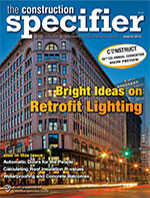 Double Specification of Roof Curbs
Double Specification of Roof Curbs
During my 31-year career of promoting and manufacturing Prefabricated Roof Curbs (commonly referred to as PFRCs) for roof-mounted equipment, I have often seen the improper specification of these curbs. In most instances, they are shown in two pairs of a specification for the same project. This is caused by lack of coordination between the architect, specification writer, and mechanical engineer. The result is a leaky roof due to improper construction and installation.
MasterFormat puts Prefabricated Roof Curbs in “Section 0720--Roof Accessories”. They do not belong in any other section, especially not in “Section 15700--Heating, Ventilating, and Air Conditioning Equipment”.
When Prefabricated Roof Curbs were introduced to the Chicago market over 30 years ago, competitive curbs were concrete and wood, with miscellaneous angles that were always field fabricated.
Custom-designed structural curbs save money on new and rebuilt projects. One of the biggest money-saving features is that these curbs eliminate most supporting angles for all roof-mounted equipment because of internal reinforcing and continuous-welded corners.
Prefabricated Curbs
Custom Prefabricated Roof Curbs were developed to eliminate roof leaks. Al roof curbs should be a minimum of 200 mm (8 in.) above the finished roof and should be welded or sheet-screwed to a metal, wood, or tectum deck or to the structural steel. On a concrete roof deck, ram setting is the most popular. The curbs are insulated with 40 mm (1 1/2 in.) 1.4 kg (3lbs.) density of rigid fiberglass installation at the job, which is difficult and more expensive, especially if curbs are canted and pitched.
Pressure-treated nailers are provided not only for receiving the roofing felts but also for eliminating noise transfer. Curbs are manufactured from 14- or 18-gauge galvanized or galvalume material and internally reinforced with 25 x 28 mm (1 x 1 1/2 in.) angles, placed every 610 mm (24 in.) on center for a curb with any dimension of 915 mm (36 in.) or longer. They can be fabricated to any height or roof pitch with options such as aluminum, stainless steel, burglar bars, wider nailer, and many other custom specifications.
A major problem with equipment manufactures' standard roof curbs is that they do not mate with many kinds of roof deck situations that are being specified. Prefabricated Roof Curbs are coordinated not only to mate with the selected equipment but with roof construction as well. Some roof curbs have raised cants to allow the roofer's insulation to mate--the roof cant starts at the finished roof and not below the insulation thickness.
Custom Prefabricated Roof Curbs are coordinated and fabricated to fit equipment that is going to be used, not to fit some roof-opening size that has been pre-determined during design as an approximate size. The curbs are flashed in before the roofer is required and therefore become part part of the roofing system. Prefabricated Roof Curbs should never be installed on top of the roofing or insulation on new or existing construction. If they are buried properly beneath the insulation, most roof leaks will be eliminated.
Field-Fabricated Curbs
A carpenter builds to roof-opening size and not to actual equipment size, many times using scrap material available on the job site. When this happens, the equipment being mounted on the job-built curb is larger than the opening, leaving a gap. In addition, this method does not take into consideration any pans or crosses needed for rooftop units. Wind and water can infiltrate the opening and soak ceiling tiles, resulting in stains and leaks that can be seen in stores in any part of the United States.
Mechanical contractors throughout the United States still use wood timbers for roof-mounted condensing units, gas pipes, and rooftop units. Wood is not the best material to use because any wood larger than 2 x 4 will start to snake and warp, especially when used as an expansion joint. Structural steel that supports rooftop units and angles that support duct work and piping are usually installed through pitch pockets. These pitch pockets are filled with roofing tar that dries out during the intense heat of the day and cracks during cool evenings. The roofer normally has to do maintenance every three months.
When cracks form, water seeps in. Wood installed on top of insulation also causes movement of gas popes, scraping away roofing stones and eventually digging into the insulation. The result is clear---water will find its way into a building.
Unfortunately, equipment manufacturers fabricate improper roof curbs because they do not design them with leak prevention in mind. Problems with different kinds of roof decks, insulation factors, and pitches are not considered in their designs, as evidenced in their typical roof curb details.
Improper curb design of rooftop HVAC units, exhaust fans, and self-finishing skylights curbs are the main reasons for most roof leaks. The equipment manufacturer concentrates on supporting only his unit and usually does not have the knowledge to follow proper roofing practices or to stay abreast of the many roofing methods and designs.
Skylight manufacturers have integrals, or self-flashing, roof curbs with no wood nailers and usually no insulation. The manufacturer does not consider a proper curb installation or determine whether it is going on a parking lot or an insulated deck, and the factors involved in each. Otherwise, the manufacturer surely would not show these typical applications.
Summary
Roof leaks can be prevented by simply specifying Prefabricated Roof Curbs only in the manner recommended by CSI under “Section 07720--Roof Accessories”. This ensures that the roof curb will mate with all roof applications and will coordinate with all equipment--mechanically, architecturally, and structurally. Responsibility rests with one source, which allows roof curbs to be on site when the steel is delivered and ensures rooftop integrity.The blame for roof failure cannot be placed on any contractor or roofing system. Generally, it can be directly traced to roof curbs that do not flash properly into various roofing installations.
Robert K. Banicki
Founder of Roof Products, Inc.

